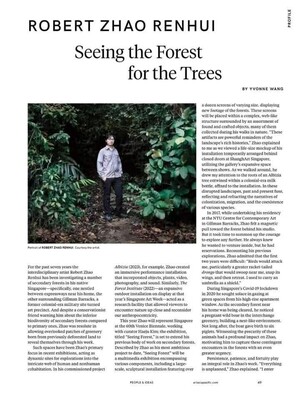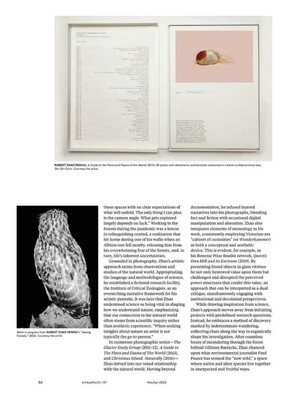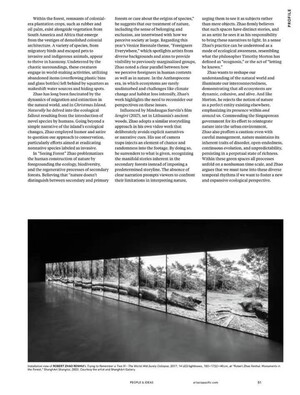For the past seven years the interdisciplinary artist Robert Zhao Renhui has been investigating a number of secondary forests in his native Singapore—specifically, one nestled between expressways near his home, the other surrounding Gillman Barracks, a former colonial-era military site turned art precinct. And despite a conservationist friend warning him about the inferior biodiversity of secondary forests compared to primary ones, Zhao was resolute in allowing overlooked patches of greenery born from previously deforested land to reveal themselves through his work.
Such spaces have been Zhao's primary focus in recent exhibitions, acting as dynamic sites for explorations into the intricate web of human and nonhuman cohabitation. In his commissioned project Albizia (2023), for example. Zhao created an immersive performance installation that incorporated objects, plants, video, photography, and sound. Similarly, The Forest Institute (2022)— an expansive outdoor installation on display at that year's Singapore Art Week—acted as a research facility that allowed viewers to encounter nature up close and reconsider our anthropocentricity.
This year Zhao will represent Singapore at the 60th Venice Biennale. working with curator Haeju Kim; the exhibition, titled "Seeing Forest," is set to extend his previous body of work on secondary forests. Described by Zhao as his most ambitious project to date, "Seeing Forest" will be a multimedia exhibition encompassing various components, including a large-scale, sculptural installation featuring over a dozen screens of varying size, displaying new footage of the forests. These screens will be placed within a complex, web-like structure surrounded by an assortment of found and crafted objects, many of them collected during his walks in nature. "These artifacts are powerful reminders of the landscape's rich histories." Zhao explained to me as we viewed a life-size mockup of his installation temporarily arranged behind closed doors at ShanghArt Singapore, utilizing the gallery's expansive space between shows. As we walked around, he drew my attention to the roots of an Albizia tree entwined within a colonial-era milk bottle, affixed to the installation. In these disrupted landscapes, past and present fuse, reflecting and refracting the narratives of colonization, migration, and the coexistence of various species.
In 2017, while undertaking his residency at the NTU Centre for Contemporary Art in Gillman Barracks, Zhao felt a magnetic pull toward the forest behind his studio. But it took time to summon up the courage to explore any further. He always knew he wanted to venture inside, but he had reservations. Recounting his previous explorations, Zhao admitted that the first two years were difficult: "Birds would attack me, particularly a greater racket tailed drongo that would swoop near me, snap its wings, and then retreat. I used to carry an umbrella as a shield.”
During Singapore's Covid-19 lockdown in 2020 he sought solace in gazing at green spaces from his high-rise apartment window. As the secondary forest near his home was being cleared, he noticed a pregnant wild boar in the interchange greenery, building a nest-like environment. Not long after, the boar gave birth to six piglets. Witnessing the precarity of these animals had a profound impact on Zhao, motivating him to capture these contingent encounters in the forests with an even greater urgency.
Persistence, patience, and fortuity play an integral role in Zhao's work, "Everything is unplanned,* Zhao explained, "I enter these spaces with no clear expectations of what will unfold. The only thing I can plan Is the camera angle. What gets captured largely depends on luck." Working in the forests during the pandemic was a lesson in relinquishing control, a realization that hit home during one of his walks when an Aibizia tree fell nearby. releasing him from his overwhelming fear of the forests, and, in turn, life's inherent uncertainties.
Grounded in photography, Zhao's artistic approach stems from observations and studies of the natural world. Appropriating the language and methodologies of science, he established a fictional research facility, the Institute of Critical Zoologists. us an overarching narrative framework for his artistic pursuits. It was here that Zhao understood science as being vital in shaping how we understand nature, emphasizing that our connection to the natural world often stems from scientific inquiry rather than aesthetic experience. "When seeking insights about nature an artist is not typically the go-to person.”
In numerous photographic series—The Glacier Study Group (2011-12), A Guide to The Flora and Fauna of The World (2013), and Christmas Island, Naturally (2016)—Zhao delved into our vexed relationship with the natural world. Moving beyond documentation, he infused layered narratives into his photographs, blending fact and fiction with occasional digital manipulation and alteration. Zhao also integrates elements of museology in his work, consistently employing Victorian-era
"cabinet of curiosities" (or Wunderkammer) as both a conceptual and aesthetic device. This is evident, for example, in his Benesse Prize finalist artwork, Queen's Own Hill and its Environs (2019). By presenting found objects in glass vitrines he not only bestowed value upon them but challenged and disrupted the perceived power structures that confer this value, an approach that can be interpreted as a dual critique, simultaneously engaging with institutional and decolonial perspectives.
While drawing inspiration from science, Zhao's approach moves away from initiating projects with predefined research questions. Instead, he embraces a method of discovery marked by indeterminate wandering, collecting clues along the way to organically shape his investigation. After countless hours of meandering through the forest behind Gillman Barracks, Zhao chanced upon what environmental journalist Fred Pearce has termed the "new wild," a space where native and alien species live together in unexpected and fruitful ways.
Within the forest, remnants of colonial-era plantation crops, such as rubber and oil palm, exist alongside vegetation from South America and Africa that emerge from the vestiges of demolished colonial architecture. A variety of species, from migratory birds and escaped pets to invasive and indigenous animals, appear to thrive in harmony. Undeterred by the chaotic surroundings, these creatures engage in world-making activities, utilizing abandoned items (overflowing plastic bins and glass bottles) left behind by squatters as makeshift water sources and hiding spots.
Zhao has long been fascinated by the dynamics of migration and extinction in the natural world, and in Christmas Island, Naturally he delved into the ecological fallout resulting from the introduction of novel species by humans. Going beyond a simple narrative of the island's ecological changes, Zhao employed humor and satire to question our approach to conservation, particularly efforts aimed at eradicating nonnative species labeled as invasive.
In "Seeing Forest" Zhao problematizes the human construction of nature by foregrounding the ecology, biodiversity, and the regenerative processes of secondary forests. Belleving that "nature doesn’t distinguish between secondary and primary forests or care about the origins of species,” he suggests that our treatment of nature, including the sense of belonging and exclusion, are intertwined with how we perceive society at large. Regarding this year's Venice Biennale theme, "Foreigners Everywhere," which spotlights artists from diverse backgrounds and aims to provide visibility to previously marginalized groups. Zhao noted a clear parallel between how we perceive foreigners in human contexts as well as in nature. In the Anthropocene era, in which ecosystems are rarely undisturbed and challenges like climate change and habitat loss intensify, Zhao's work highlights the need to reconsider our perspectives on these issues.
Influenced by Mindaugas Survila's film Sengirė (2017), set in Lithuania's ancient woods, Zhao adopts a similar storytelling approach in his own video work that deliberately avoids explicit narratives or narrative cues. His use of camera traps injects an element of chance and randomness into the footage. By doing so, he surrenders to what is given, recognizing the manifold stories inherent in the secondary forests instead of imposing a predetermined storyline. The absence of clear narration prompts viewers to confront their limitations in interpreting nature, urging them to see it as subjects rather than mere objects. Zhao firmly believes that such spaces have distinct stories, and as an artist he sees it as his responsibility to bring these narratives to light. In a sense Zhao's practice can be understood as a mode of ecological awareness, resembling what the philosopher Timothy Morton has defined as "ecognosis," or the act of "letting be known.”
Zhao wants to reshape our understanding of the natural world and illuminate our interconnectedness, demonstrating that all ecosystems are dynamic, cohesive, and alive. And like Morton, he rejects the notion of nature as a perfect entity existing elsewhere, emphasizing its presence within and around us. Commending the Singaporean government for its effort to reintegrate nature into the urban environment, Zhao also proffers a caution: even with careful management, nature maintains its Inherent traits of disorder, open-endedness. continuous evolution, and unpredictability, persisting in a perpetual state of richness. Within these green spaces all processes unfold on a nonhuman time scale, and Zhao argues that we must tune into these diverse temporal rhythms if we want to foster a new and expansive ecological perspective.
Seeing the Forest for the Trees
Source: ArtAsiaPacific Author: Yvonne Wang 2024-02-29




